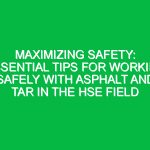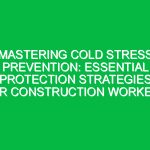As the mercury rises, so does the risk of heat-related illnesses, especially in the physically demanding world of construction work. With the sun beating down and the humidity wrapping around you like a thick blanket, staying safe and healthy on the job site becomes a top priority. This comprehensive guide delves into essential strategies for heat illness prevention in the construction industry, ensuring that workers stay cool, hydrated, and productive, even under the scorching sun.
Understanding the Risks: Heat Illness in Construction
Before diving into prevention strategies, it’s crucial to understand what heat illness is and why construction workers are particularly vulnerable. Heat illness can range from mild conditions like heat rash and heat cramps to more severe forms such as heat exhaustion and heat stroke, the latter of which can be fatal if not treated promptly.
Construction workers are at a higher risk due to the physical nature of their work, exposure to direct sunlight, and often, the lack of immediate access to shade or cool environments. Recognizing the signs of heat illness, which include dizziness, nausea, headache, rapid heartbeat, and extreme fatigue, is the first step in combating this potentially deadly condition.
Strategies for Heat Illness Prevention
Hydration is Key
One of the simplest yet most effective ways to prevent heat illness is to stay hydrated. Drinking water regularly throughout the day is essential, even if you’re not thirsty. Construction sites should have cool, potable water readily available, and workers are encouraged to drink at least one cup every 15-20 minutes during hot weather.
Acclimatize to the Heat
Acclimatization is the process of allowing your body to gradually adapt to high temperatures. This is particularly important for new workers or those returning after a significant break. Gradually increase workload and exposure over a 7-14 day period to help your body adjust more effectively to the heat.
Wear Appropriate Clothing
Choosing the right clothing can significantly impact your comfort and safety in hot conditions. Lightweight, light-colored, and loose-fitting clothing helps keep your body cool. Hats and other protective gear designed to shield you from the sun’s rays are also crucial.
Schedule for the Weather
Whenever possible, heavy work should be scheduled during the cooler parts of the day, such as early morning or late afternoon. Taking regular breaks in shaded or air-conditioned areas can also help workers avoid overheating.
Use Cooling Products
Today, there are numerous products available designed to help lower body temperature, including cooling vests, bandanas, and wristbands. These can be particularly useful for workers who must wear heavy protective gear that limits airflow.
Monitor Weather Conditions
Keeping a close eye on the weather forecast can help you prepare for extreme heat. Be aware of heat advisories, warnings, and watches issued by local weather services and plan accordingly.
Implement a Buddy System
Heat illness can impair judgment and make it difficult for someone to recognize their own symptoms. Working in pairs or groups ensures that someone can always look out for signs of heat stress in their coworkers.
Provide Training and Education
Knowledge is power when it comes to preventing heat illness. Regular training sessions should be held to educate workers on the signs of heat illness, the importance of hydration, and the proper use of protective clothing and gear.
Creating a Heat Illness Prevention Plan
For construction companies, having a formal heat illness prevention plan in place is not just a good practice—it’s a necessity. This plan should outline the specific measures the company will take to protect workers from heat stress, including emergency response procedures, training programs, and daily work/rest schedules tailored to current weather conditions.
Regular reviews and updates to the plan ensure that it remains effective and compliant with any new safety regulations. Involving workers in the creation and revision of the plan can also help identify potential issues and improve overall compliance and effectiveness.
Conclusion: Staying Safe in the Heat
Heat illness is a serious concern in the construction industry, but with the right strategies, it can be prevented. By staying hydrated, wearing appropriate clothing, scheduling work for cooler times of the day, and closely monitoring weather conditions, construction workers can protect themselves from the dangers of heat stress. Additionally, creating a comprehensive heat illness prevention plan and ensuring all workers are educated on the signs and symptoms of heat-related illnesses are crucial steps in safeguarding the health and safety of everyone on the job site.
Remember, beating the heat is not just about comfort—it’s about preventing potentially life-threatening conditions. By taking proactive steps and working together, construction teams can ensure that they stay safe, healthy, and productive, no matter how high the temperatures climb.


